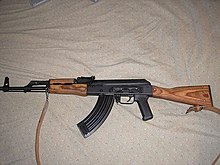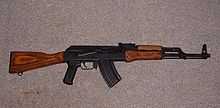
A firearm is any type of gun that uses an explosive charge and is designed to be readily carried and used by an individual. The term is legally defined further in different countries.

In firearms terminology, an action is the functional mechanism of a breech-loading firearm that handles the ammunition cartridges, or the method by which that mechanism works. Actions are technically not present on muzzleloaders, as all those are single-shot firearms with a closed off breech with the powder and projectile manually loaded from the muzzle. Instead, the muzzleloader ignition mechanism is referred to as the lock.
A semi-automatic firearm, also called a self-loading or autoloading firearm, is a repeating firearm whose action mechanism automatically loads a following round of cartridge into the chamber and prepares it for subsequent firing, but requires the shooter to manually actuate the trigger in order to discharge each shot. Typically, this involves the weapon's action utilizing the excess energy released during the preceding shot to unlock and move the bolt, extracting and ejecting the spent cartridge case from the chamber, re-cocking the firing mechanism, and loading a new cartridge into the firing chamber, all without input from the user. To fire again, however, the user must actively release the trigger, allow it to "reset", before pulling the trigger again to fire off the next round. As a result, each trigger pull only discharges a single round from a semi-automatic weapon, as opposed to a fully automatic weapon, which will shoot continuously as long as the ammunition is replete and the trigger is kept depressed.
The RPK, sometimes retroactively termed the RPK-47, is a Soviet 7.62×39mm light machine gun that was developed by Mikhail Kalashnikov in the early 1960s, in parallel with the AKM assault rifle. It was created to standardize the small arms inventory of the Soviet Army, where it replaced the 7.62×39mm RPD machine gun. The RPK continues to be used by the military of the post-Soviet states and certain African and Asian nations. The RPK is also manufactured in Bulgaria, Hungary, Romania, and Serbia.

The Saiga-12 is a shotgun available in a wide range of configurations, patterned after the Kalashnikov series of rifles and named after the Saiga antelope native to Russia. Like the Kalashnikov rifle variants, it is a rotating bolt, long-stroke gas piston operated firearm that feeds from a square magazine. All Saiga-12 configurations are recognizable as Kalashnikov-pattern guns by the large lever-safety on the right side of the receiver, the optic mounting rail on the left side of the receiver and the large top-mounted dust cover held in place by the rear of the recoil spring assembly. Saiga firearms are meant for civilian domestic sale in Russia, and export to international markets.

The AK-107 is a Russian 5.45×39mm assault rifle developed from the AK-100-series. It features a "balanced" operating system, similar to that used in the AEK-971. In this case, the designation AK does not indicate Avtomat Kalashnikova but Alexandrov/Kalashnikov. The revised designation indicates the incorporation of a new gas system, designed by Youriy Alexandrov, for Kalashnikov-pattern rifles.

The ArmaLite AR-7 Explorer is a semi-automatic firearm in .22 Long Rifle caliber, developed in 1959 from the AR-5 that was adopted by the U.S. Air Force as a pilot and aircrew survival weapon. The AR-7 was adopted and modified by the Israeli Air Force as an aircrew survival weapon in the 1980s.
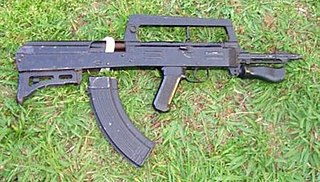
The Norinco Type 86S is an AKM-type bullpup rifle that was produced by Norinco. Many major parts are interchangeable with other standard Kalashnikov rifles.

The AKM is an assault rifle designed by Soviet small arms designer Mikhail Kalashnikov in 1959. It was developed as the successor to the AK-47 adopted by the USSR a decade prior.
The Saiga semi-automatic rifles are a family of Russian semi-automatic rifles manufactured by Kalashnikov Concern, which also manufactures the original AK-47 and its variants, Saiga-12 shotguns and Dragunov sniper rifle. Saiga rifles are a sport version of the Kalashnikov rifle, and are marketed for hunting and civilian use. They are sometimes referred to as Saiga Sporters.
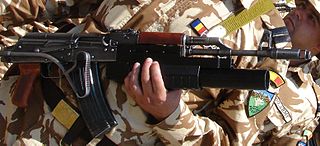
The Pușcă Automată model 1986 is the standard assault rifle used by the Romanian Military Forces and manufactured in Cugir, Romania by the ROMARM firm, located in Bucharest. The export name for this variant is the AIMS-74.

The Pistol Mitralieră model 1963/1965 is a Romanian 7.62x39mm assault rifle. Developed in the late 1950s, the PM md. 63 was a derivative of the Soviet AKM produced under license. It was the standard issue infantry weapon of the Army of the Socialist Republic of Romania until the late 1980s, after which it was gradually superseded by the Pușcă Automată model 1986, a derivative of the Soviet AK-74.

An assault rifle is a select fire rifle that uses an intermediate-rifle cartridge and a detachable magazine. Assault rifles were first put into mass production and accepted into widespread service during World War II. The first assault rifle to see major usage was the German StG 44, a development of the earlier Mkb 42. While immediately after World War II, NATO countries were equipped with battle rifles, the development of the M16 rifle during the Vietnam War prompted the adoption of assault rifles by the rest of NATO. By the end of the 20th century, assault rifles had become the standard weapon in most of the world's armies, replacing full-powered rifles and submachine guns in most roles. The two most successful modern assault rifles are the AK-47 and the M16 designs and their derivatives.
The NHM-91 is a semi-automatic civilian development of the Russian Kalashnikov AKM and RPK infantry small arm built by Norinco of China and marketed in the U.S. by China Sports Inc. of Ontario, California.
The AK-12, "Avtomat Kalashnikova, 2012" is a Russian gas-operated assault rifle chambered in 5.45×39mm designed and manufactured by the Kalashnikov Concern, making it the fifth generation of Kalashnikov rifles.
The PSL is a Romanian designated marksman rifle. It is also called PSL-54C, Romak III, FPK and SSG-97. Though similar in appearance, mission and specifications to the SVD Dragunov, the PSL rifle is mechanically completely different as it is based on the AKM assault rifle, with its internals simply being scaled up to accommodate the more powerful 7.62×54mmR cartridge.
The Zastava PAP are a series of Serbian sporting rifles based on the Zastava M70 and Zastava M77B1. They are nearly identical to their military counterparts, but lack select-fire capability and have been modified with a number of sporting features designed to comply with firearms imports laws in the United States, where they are primarily marketed.
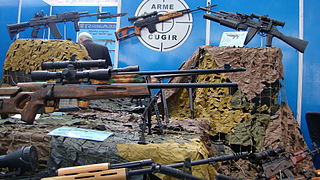
Cugir Arms Factory is a Romanian state owned defence company that is one of the oldest defence companies of Romania. Cugir Arms Factory has a history that can be traced back to 1799 during the Austrian Empire. The steel manufacturing workshops were founded in Cugir, Romania which is one of the first metallurgical factories in Transylvania. Cugir Arms Factory now produces products compatible with NATO standards.

A cadet rifle is a rifle used by military cadets and others for basic firearms and marksmanship training. Generally .22 caliber and bolt-action, they also come in semi-automatic versions. They are often miniature .22 caliber versions of standard issue service rifles.
The WASR-22 or AK-22 Trainer is a .22 Long Rifle, semi-automatic cadet rifle loosely based upon the AK-47 and manufactured in Romania by Nova Modul. Unlike the AK-47, it uses a simple blowback method of operation. As such, it has no gas system and the internal components have been modified accordingly.
